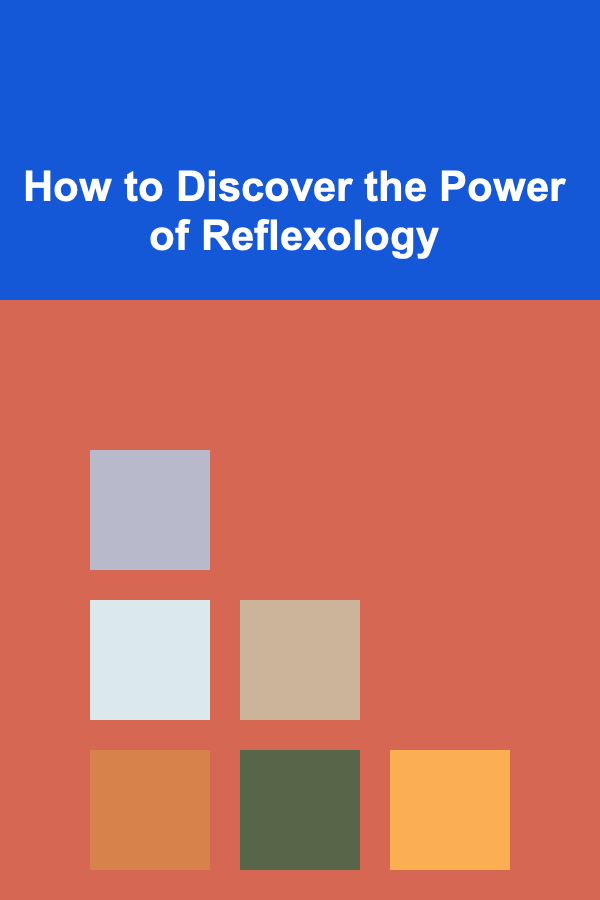
How to Discover the Power of Reflexology
ebook include PDF & Audio bundle (Micro Guide)
$12.99$9.99
Limited Time Offer! Order within the next:

Reflexology is an ancient healing art that traces its roots back thousands of years, with influences from Chinese, Egyptian, and Indian medicine. Today, it is widely regarded as a complementary therapy that focuses on the principle that specific points on the feet, hands, and ears are connected to different organs and systems in the body. By applying gentle pressure to these points, reflexologists believe they can promote healing, reduce stress, and improve overall health.
In this article, we will explore the fascinating world of reflexology, uncovering its history, principles, benefits, and how you can discover and harness its power for better health and well-being.
The Origins of Reflexology
The concept of reflexology dates back to ancient civilizations, with early references appearing in Egyptian and Chinese medical texts. The oldest known documentation of reflexology is found in the tomb of an Egyptian physician, where images of foot massages and healing techniques were depicted on the walls. These ancient practices were based on the idea that the body's various organs could be influenced by stimulating specific points on the hands and feet.
In China, the practice of foot reflexology is deeply ingrained in traditional Chinese medicine (TCM). Chinese healers believed that the feet were a microcosm of the body, with each foot corresponding to specific organs and energy pathways, known as meridians. Similarly, in India, reflexology practices were part of Ayurvedic medicine, which emphasized balancing the body's energies to maintain health.
Although reflexology became widely practiced in the West in the 20th century, it was in the early 1900s that the modern form of reflexology began to take shape. Dr. William Fitzgerald, an American ear, nose, and throat specialist, is often credited with developing the foundation of reflexology in the Western world. Fitzgerald's "zone therapy" theory suggested that the body could be divided into ten energy zones, and by applying pressure to specific points on the feet and hands, the energy flow could be balanced, leading to improved health.
The Principles of Reflexology
At its core, reflexology is based on the idea that the body is interconnected through an energy system, and that stimulating certain reflex points can influence the flow of energy and promote healing. The key principles of reflexology are:
1. Reflex Points Correspond to Organs and Systems
Reflexologists believe that specific points on the feet, hands, and ears correspond to different organs and systems in the body. For example, the tips of the toes are thought to correspond to the head and neck, while the arch of the foot is believed to represent the digestive system. By applying pressure to these points, reflexologists aim to restore balance and improve the function of the related organs or systems.
2. Energy Flow and Balance
In reflexology, the body is viewed as a network of energy pathways. When the energy flow is blocked or unbalanced, it is believed to result in illness or discomfort. Reflexology aims to restore balance to these energy pathways, allowing the body's natural healing processes to take place. This concept is similar to the idea of Qi (pronounced "chee") in Chinese medicine, which is the life force or vital energy that flows through the body.
3. Holistic Approach
Reflexology is a holistic therapy, meaning it treats the whole person rather than focusing on specific symptoms or conditions. Practitioners of reflexology believe that by stimulating the reflex points, they can address underlying causes of health problems, rather than simply alleviating symptoms. This approach is designed to promote overall well-being by balancing the body, mind, and spirit.
4. Self-Healing Mechanism
One of the central tenets of reflexology is that the body has an innate ability to heal itself. By encouraging the flow of energy and stimulating reflex points, reflexology aims to activate the body's natural healing mechanisms. This may lead to improved circulation, better lymphatic drainage, reduced stress, and enhanced organ function.
The Benefits of Reflexology
Reflexology is often sought out for its potential to promote relaxation and alleviate stress. However, its benefits extend beyond relaxation, and it has been found to be helpful for a wide range of physical, emotional, and mental health concerns. Some of the most commonly reported benefits of reflexology include:
1. Stress Relief and Relaxation
One of the most well-known benefits of reflexology is its ability to reduce stress and promote deep relaxation. Reflexology stimulates the parasympathetic nervous system, which is responsible for the body's "rest and digest" functions. By activating this system, reflexology can lower heart rate, reduce blood pressure, and promote a sense of calm and relaxation.
2. Improved Circulation
Reflexology may help improve circulation by stimulating the flow of blood and oxygen to various parts of the body. This can enhance the delivery of nutrients to cells and tissues while also supporting the removal of waste products from the body. Improved circulation can contribute to better overall health, faster recovery from illness or injury, and reduced swelling and inflammation.
3. Pain Relief
Reflexology has been reported to provide relief from various types of pain, including headaches, back pain, and menstrual cramps. By stimulating specific reflex points, reflexologists may help release endorphins, the body's natural painkillers. Reflexology has also been used as a complementary treatment for conditions such as fibromyalgia and arthritis.
4. Enhanced Immune System Function
The stimulation of reflex points in reflexology is thought to promote the healthy functioning of the body's immune system. By improving circulation, reducing stress, and balancing energy flow, reflexology may help strengthen the body's natural defenses against illness and infection.
5. Improved Digestion
Reflexology is often used to support digestive health. By stimulating reflex points associated with the digestive system, reflexologists aim to improve the functioning of the stomach, intestines, and other digestive organs. This may help alleviate conditions such as indigestion, constipation, and bloating.
6. Mental Clarity and Emotional Balance
Reflexology can also have a positive impact on mental and emotional health. Many people report feeling clearer, more focused, and more emotionally balanced after a reflexology session. By reducing stress and promoting relaxation, reflexology can help improve mood and alleviate feelings of anxiety or depression.
How to Discover the Power of Reflexology
If you're curious about how reflexology can benefit you, there are several ways you can explore and discover its power. Whether you're interested in trying it for relaxation, pain relief, or overall well-being, here are some steps to get started:
1. Find a Qualified Reflexologist
The first step in discovering the power of reflexology is to find a qualified reflexologist who can guide you through the process. Reflexologists are trained professionals who have studied the anatomy of the feet, hands, and ears, as well as the principles of reflexology. Look for a reflexologist who is certified by a recognized reflexology association, as this ensures they have received proper training and adhere to ethical standards.
2. Try a Session
Once you've found a qualified reflexologist, the next step is to schedule a session. A typical reflexology session lasts between 30 minutes to an hour and involves the reflexologist applying gentle pressure to specific points on your feet, hands, or ears. During the session, you may feel a range of sensations, from mild discomfort to deep relaxation. Many people report feeling deeply relaxed and rejuvenated after a session.
3. Practice Self-Reflexology
In addition to receiving professional reflexology treatments, you can also practice self-reflexology at home. There are many resources, including books and online tutorials, that can teach you how to apply pressure to the reflex points on your feet and hands. Self-reflexology can be a great way to complement professional treatments and maintain a sense of balance and well-being on a daily basis.
4. Explore Other Complementary Therapies
Reflexology can be most effective when used in conjunction with other complementary therapies, such as acupuncture, massage, or aromatherapy. By combining these practices, you can maximize the benefits of reflexology and promote holistic healing for your body and mind.
5. Observe Your Results
After several sessions of reflexology, take note of how you feel. Many people find that they experience significant improvements in their physical health, emotional well-being, and overall quality of life. Whether you're seeking stress relief, pain reduction, or improved energy, reflexology can offer a powerful tool for enhancing your health and well-being.
Conclusion
Reflexology is a powerful healing practice that has stood the test of time. With its roots in ancient medicine, reflexology offers a holistic approach to improving health by stimulating specific points on the feet, hands, and ears. Whether you're seeking stress relief, pain reduction, or enhanced immune function, reflexology can offer a natural and effective way to support your overall health and well-being.
By discovering the power of reflexology, you can tap into the body's innate ability to heal itself, promoting balance, relaxation, and vitality. So, whether you choose to seek professional reflexology treatments or practice self-reflexology at home, take the first step today and experience the transformative benefits of this ancient healing art.

Creating Passive Income Streams with Deep Learning
Read More
How to Create a Personal Library at Home
Read More
How to Decorate a Fresh Christmas Tree from Home Depot with Ease
Read More
How to Handle Maintenance Requests Quickly and Efficiently
Read More
How to Incorporate Fun Cooking Projects with Your Family
Read More
How to Make a Checklist for Staying Motivated During Your Job Search
Read MoreOther Products

Creating Passive Income Streams with Deep Learning
Read More
How to Create a Personal Library at Home
Read More
How to Decorate a Fresh Christmas Tree from Home Depot with Ease
Read More
How to Handle Maintenance Requests Quickly and Efficiently
Read More
How to Incorporate Fun Cooking Projects with Your Family
Read More